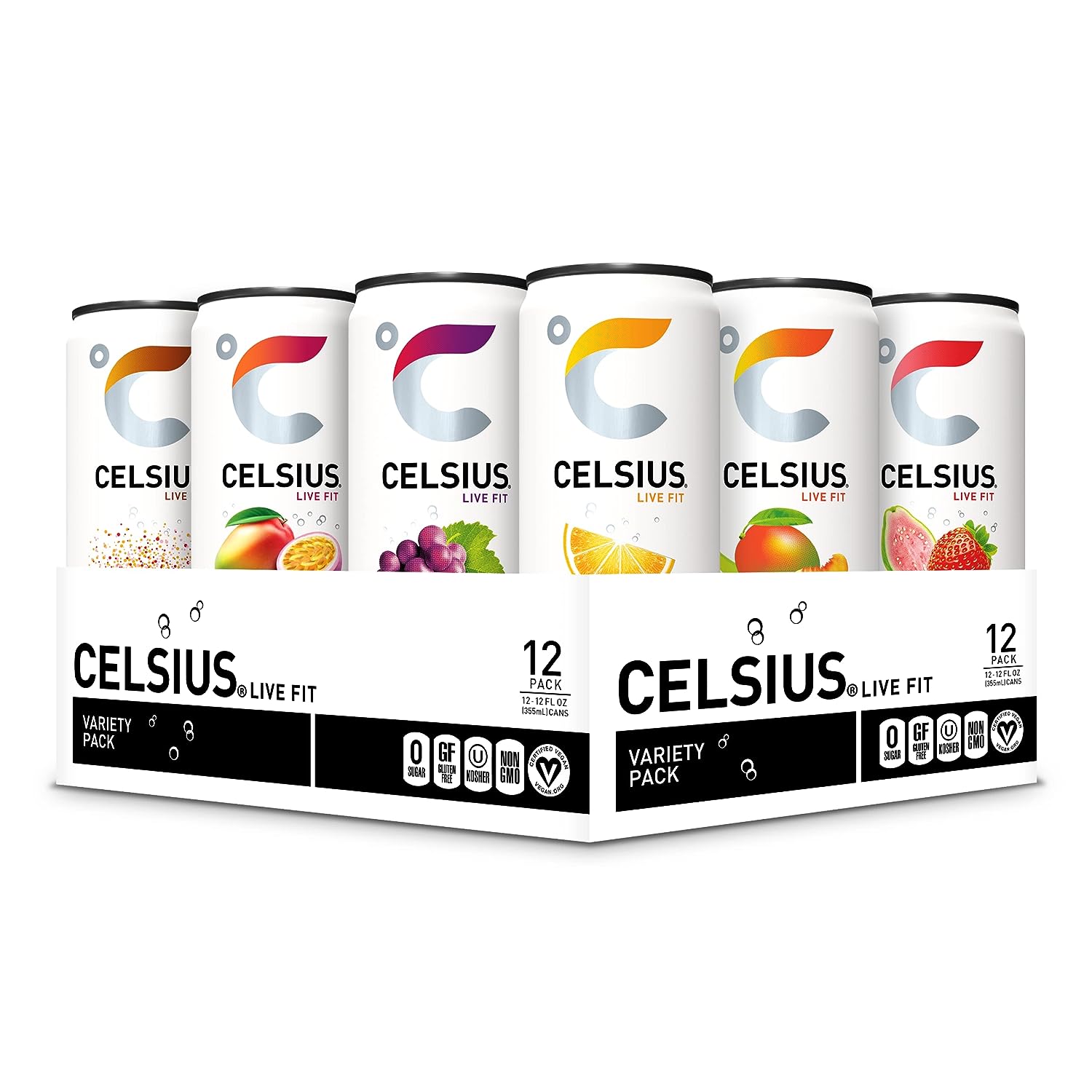The CELSIUS Bulk Variety Pack, containing assorted flavors, is a functional essential energy drink that promises to provide a much-needed boost of energy. With a variety of flavors and a range of certifications, this product aims to cater to different taste preferences while offering a healthier alternative to traditional energy drinks.
I have been a fan of CELSIUS energy drinks for a while now, and the Assorted Flavors Official Variety Pack did not disappoint. The pack offers a delightful assortment of flavors that not only provide an energy boost but also excite the taste buds. From tangy to refreshing and from fruity to bold, each can in the pack introduces a unique and enjoyable taste experience. I particularly enjoyed the Sparkling Orange flavor, which delivered a zesty and citrusy burst of flavor that left me feeling invigorated. The clean energy provided by CELSIUS drinks is a game-changer, as I never experienced any crashes or jitters commonly associated with other energy drinks.
Great Flavor, Quality Control Can Be Lacking

To be honest, CELSIUS energy drinks are my go-to brand and they never leave me feeling sick like other brands do. My favorite is definitely the orange, but sometimes there are quality control issues. Cans often arrive slightly dented, and sometimes the flavor tastes slightly different or off. It’s almost like they used the same machine to fill multiple flavors but didn’t properly clean them in between. That being said, they still always taste good and provide much-needed energy.
CELSIUS Bulk Variety Pack: A Flavorful Assortment of Energy-Boosting Drinks

Not only does the CELSIUS Official Variety Pack provide a much-needed energy boost, but it also offers a delightful array of flavors that excite the taste buds. This pack is perfect for those who crave variety and enjoy exploring different flavor profiles. Let’s dive into the review and highlight the taste differences found within this pack.One of the standout features of the CELSIUS Official Variety Pack is the wide range of flavors it offers. Each can in the pack introduces a unique taste experience, ensuring that you never get bored with your energy drink choices. From tangy to refreshing, and from fruity to bold, this assortment caters to various flavor preferences, making it suitable for a diverse range of palates.The pack typically includes flavors such as Sparkling Orange, Sparkling Watermelon, Sparkling Wild Berry, and Sparkling Cola. These flavors provide a refreshing twist to the typical energy drink options available in the market. Each flavor is distinct and well-crafted, offering a pleasant burst of taste with every sip.
The Ultimate Energy Boost with Flavor Variety!
When it comes to functional energy drinks, the CELSIUS Assorted Flavors Official Variety Pack is a complete game-changer. This pack of 12 energy-packed beverages has transformed the way I stay energized throughout the day, and I can’t help but give it a well-deserved 5-star review.Variety is the Spice of Life: The first thing that caught my attention is the assortment of flavors in this variety pack. With a wide selection to choose from, I never get bored. Whether I’m in the mood for sparkling orange, refreshing berry, or zesty grapefruit, this pack has a flavor to match every craving.Clean Energy Without the Crash: Unlike traditional energy drinks that leave you with a dreaded crash, CELSIUS provides clean energy. It’s powered by natural caffeine sources like green tea extract and guarana, giving me a sustained energy boost without the jitters or a midday slump.Essential Vitamins: These energy drinks don’t just provide a pick-me-up; they also deliver essential vitamins like BCAAs, Biotin, and more. It’s like a nutritional bonus with every sip, which I appreciate as part of my daily routine.Zero Sugar, Zero Preservatives: CELSIUS understands the importance of a healthy energy source. With zero sugar and zero preservatives, I can enjoy these drinks guilt-free. It’s a refreshing change from sugar-laden alternatives.Perfect for On-the-Go: Whether I’m heading to the gym, hitting the trails, or simply need an energy boost at work, these 12-ounce cans are conveniently sized and easy to take with me. They fit perfectly in my bag or cup holder, making them an ideal companion for busy days.Refreshing and Hydrating: CELSIUS drinks are not only energizing but also incredibly refreshing and hydrating. They quench my thirst and keep me revitalized during workouts and daily activities.
Mostly Good Flavors, Almost Always Arrive Undamaged, Read the Fine Print on the Variety Pack
What I like about CELSIUS is that I enjoy most of their flavors and rarely dislike any, making the variety pack a safe choice for me to order without getting tired of the flavors. For whatever reason, these usually arrive to me safely and undamaged, compared to other canned drinks which would often arrive bent or not arrive at all because the box was damaged in transit from the liquid spilling out. Even though these are smaller cans than some 16oz energy drinks, they still last me a while, and one will give me my caffeine fix for the day.Bad: This is solely directed at the variety packs. These will sometimes ship with flavored CELSIUS teas which I’m not a fan of (I prefer good ol’ fashioned black teas) and also a flavor called Mandarin Marshmallow which is disgusting. You will not get the pictured variety. They will put in whatever flavors are available, and it will change on a per-order basis.Overall, a good value, I feel!
CELSIUS Bulk Variety Pack: Really Love the Flavors
I recently had the pleasure of trying CELSIUS drinks and was pleasantly surprised by how delicious the flavors were. The peach flavor, in particular, was a standout – it had a refreshing and authentic taste that I thoroughly enjoyed. The tropical flavor was also delightful, offering a perfect blend of exotic fruitiness that was both energizing and satisfying. Both flavors had a great balance, not too sweet but flavorful enough to be enjoyable. These drinks are a great pick-me-up for anyone looking for a tasty energy boost.
A Great Source of Energy Without a Crash
My boss is the one who introduced me to CELSIUS and I’m grateful for the recommendation. As someone who is always on the go, I’m constantly looking for healthier ways to get an energy boost. CELSIUS seems to have exploded on the market, and it seems like everyone I know these days absolutely loves it. I am particularly fond of the orange-flavored CELSIUS and go for it on a pretty regular basis.This is a 12-pack of 12-fluid ounce cans of sparkling orange energy drink. This is kosher, gluten-free, and vegan.Key ingredients include Vitamin B, Guarana Seed Extract, Green Tea Extract, Chromium, Ginger Root, Vitamin B7, and Vitamin C. There are 10 calories per serving.There are a number of things I appreciate about CELSIUS Orange – The “sparkle” blends nicely with the flavor, the energy boost is more subtle than some energy drinks, and I don’t experience a crash. I’ve noticed that I don’t get that fierce craving, which I hate, that comes with some energy drinks that leave you wanting more. I can drink a can of CELSIUS and be satisfied. I love that.This is definitely not what I’d consider a value drink, though that’s typically true of more natural options. However, I also don’t consider it unreasonable.I pretty much love everything about this – the energy boost is real and effective, the taste is awesome, the sparkle dazzles, there’s no crash, and it leaves me feeling energized in a more balanced way. CELSIUS Orange has definitely become an energy drink I turn to on a fairly regular basis.
Pros:
- Functional, Essential Energy with 200mg Caffeine to help you LIVE FIT.
- Made with Premium, Proven Ingredients and 7 Essential Vitamins.
- No Sugar, No Sodium. No High Fructose Corn Syrup, No Aspartame, No Artificial Colors.
Cons:
- Quality Control can be lacking, with cans often arriving slightly dented.
- Occasionally, the flavor may taste slightly different or off, possibly due to cross-contamination during production.
- The product’s marketing claims of “no artificial colors” can be misleading, as it does contain an artificial sweetener, Sucralose.
Conclusion
In conclusion, the CELSIUS Assorted Flavors Official Variety Pack is a winner in my book. With its range of delicious flavors, clean energy, and essential vitamins, it offers a healthier and more enjoyable way to stay energized throughout the day. Whether you’re an athlete, a busy professional, or simply someone seeking a flavorful and revitalizing experience, this pack is a fantastic choice. I highly recommend trying it for yourself and saying goodbye to energy slumps. CELSIUS has earned its 5-star rating, and I believe it will exceed your expectations too.
Questions & Answers:
Question: Are the variety pack flavors enjoyable?
Answer: Yes, the CELSIUS Official Variety Pack offers a delightful assortment of flavors that excite the taste buds. Each flavor is distinct and well-crafted, providing a pleasant burst of taste with every sip.
Question: Is CELSIUS a good source of energy without a crash?
Answer: Absolutely. CELSIUS provides clean energy with natural caffeine sources, like green tea extract and guarana, giving a sustained energy boost without the jitters or midday slump.
Question: Are these energy drinks suitable for those with dietary restrictions?
Answer: Yes, CELSIUS is gluten-free, kosher, non-GMO, and certified vegan. It is made with premium ingredients and does not contain sugar, sodium, high fructose corn syrup, or aspartame.

